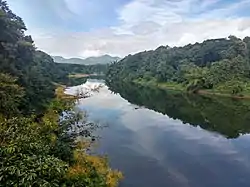Chaliyar
Chaliyar is the fourth longest river in Kerala at 169 km in length. The Chaliyar is also known as Chulika River or Beypore River as it nears the sea. Nilambur, Edavanna, Areekode, Kizhuparamba, Cheruvadi, Edavannappara, Mavoor, Peruvayal, Feroke and Beypore are some of the towns/villages situated along the banks of Chaliyar. It mainly flows through Malappuram district. A small portion of the river flows through Kozhikode district too.
| Chaliyar ചാലിയാർ | |
|---|---|
 | |
 Labelled map of Chaliyar | |
| Location | |
| Country | India |
| State | Kerala, Tamil Nadu |
| District | Malappuram, Kozhikode |
| City | Nilambur, Edavanna, Areekode, Kizhuparamba, cheekode, Vazhakkad, Cheruvadi, Mavoor, Peruvayal, Aakode, Feroke, Beypore. |
| Physical characteristics | |
| Source | Elambaleri Hills |
| • location | Western Ghats, Wayanad, India |
| Mouth | Lakshadweep Sea[1] |
• location | Beypore, Kerala, India |
• coordinates | 11.16°N 75.80°E |
• elevation | 0 m (0 ft) |
| Length | 169 km (105 mi)[1] |
| Basin size | 2,933 km2 (1,132 sq mi) |
| Discharge | |
| • location | mouth |
| Basin features | |
| Tributaries | |
| • left | Iruvazhinjipuzha, Cherupuzha, Engappuzha |
| • right | Cherupuzha Nilambur |
Name
The river has two names - Chaliyar and Beypore puzha, of which the former is more popular. The river meets the Lakshadweep Sea[1] at an 'azhi' (estuary), the southern part of which is known as Chaliyam and northern part as Beypore. Thus the river gets the names Chaliyar and Beypore River. Unlike many other rivers in Kerala, Chaliyar does not dry up during the drought season in March and April.
Course
The Chaliyar originates in the Western Ghats range at Elambalari Hills in the Wayanad Plateau of Kerala[2] and flows through Malappuram District for most of its length and then for around 17 km it forms the boundary between Malappuram District and Kozhikode District before entering the city of Kozhikode for its final 10 km journey and finally empties into the Lakshadweep Sea. Six major streams Chaliyarpuzha, Punnapuzha, Kanjirapuzha, Karimpuzha, Iruvahnipuzha and Thottumukkam Puzha (Cherupuzha) constitute the Chaliyar River drainage system. Other important tributaries are Kurumanpuzha, Pandipuzha, Maradipuzha, Kuthirapuzha and Karakkodupuzha. Most of these rivers have their origin in the Nilgiri hills in the east and Wayanad hills in the north, where they form a number of rapids and waterfalls.[2] Near the origin of river are the Meenmutty Falls at coordinates 11.527755°N 76.236534°E by Vaduvanchal, Wayanad
Economy
During late 19th century and early 20th century, the Chaliyar was extensively used as a waterway for carrying timber from the forest areas in and around Nilambur to the various mills in Kallai of Calicut city. Rafts made of logs were taken downstream during the monsoon season to Kallayi, where these were sawn to size in the timber mills dotting the banks of the river. Kallai was during this period one of the most important centers in the world for timber business. The place was famous for wood of superlative strength and durability like teak, rosewood, etc. Towards the second half of the 20th century, the activity came down drastically as tree felling was banned or strictly controlled with a view to stop deforestation. Many mills still operate in Kallai, though with far less output. Many have closed down.
Ecology



Chaliyar River was in the news a few years ago because of the ecological damage caused by a pulp factory at Mavoor, that released effluents into the river and affected the marine life. This factory has since closed down.
K. A. Rahman led the agitation for cleanup of the river, and inspired the formation of an anti-pollution committee, Paristhithi Samrakshana Samithi, in 1999.
Tributaries
- Cherupuzha (Mavoor)
- Engappuzha
- Iruthullippuzha
- Kadungampuzha
- Iruvanjippuzha
- Pulingappuzha
- Chalippuzha
- Muthappanpuzha
- Cherupuzha (Areekode)
- Kuthirappuzha
- Kuruvanpuzha
- Kanjirappuzha
- Karimpuzha
- Pandippuzha
- Neerppuzha
- Thottumukkam puzha
In addition to these rivers some creeks also join Chaliyar from Neelithode, Poonkudi, Vadasseri, Edavanna, Kunduthodu and Mampad.
Tourism

Elamaram is a village in the Indian state of Kerala. It is situated near Edavannappara in Malappuram District of Kerala. This village is very scenic as it is on the bank of Chaliyar. There is a ferry service here that can take you to the northern side of the Chaliyar river. The ticket is Rs.5.00 and the motor boat service is available every half an hour between 6.40 a.m. and 8.40 p.m. including Sundays.
Ghost Town
Across the river Chaliyar lies the abandoned Grasim Industries factory which once employed 2,000 employees. Environmental agitations in 1998 caused the closure of the factory and the entire village went bankrupt because of the sudden development and eleven people even committed suicide because of not being able to face unexpected poverty.
Pilgrimage
The Konnara Dargah is three kilometres away from Elamaram on the bank of the Chaliyar river. It is the holy resting place of a Muslim saint where hundreds of pilgrims visit regularly.
Nearby villages
- Irumooliparamba, Kottupadam, Kakkove, Channayil Palliyali (Santhigram), Akode, Virippad, Korappadam, Mundumuzhi, Vazhakkad, Valillappuzha, Pancheeri, Palakkd, Elamaram, Mepram, Konnar, Vettathur, Cheruvadikavu, Kondotty, Neerad, Muthuvalloor, Moochikal, Mundakkulam, Muthuparamba, Vettukad, Omanoor, Ponnad, Iruppanthody Karatt Chola Kolambalam Edavannappara, Arappuzha
See also
References
- "Evolution of Chaliyar River Drainage Basin Insights from Tectonic Geomorphology" (PDF). Cochin University of Science and Technology. p. 220. Retrieved 25 March 2014.
- "Evolution of Chaliyar River Drainage Basin Insights from Tectonic Geomorphology" (PDF). Cochin University of Science and Technology. pp. 8–11. Retrieved 25 March 2014.
- "Infobox facts". All Kerala River Protection Council. Retrieved 27 August 2005.
- The River Chaliyar, by M. P. Chandran
- About the Rivers of Kerala
- K A Rahman
External links
| Wikimedia Commons has media related to Chaliyar River. |